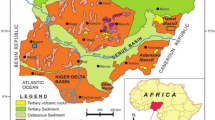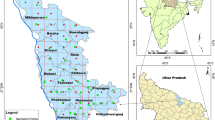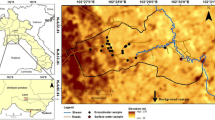Abstract
An integrated physicochemical and hydrogeochemical assessment was carried out at an automobile junk market in Obosi and in residential areas in Anambra State, south-eastern Nigeria to examine the concentration of heavy metals in the groundwater and determine the quality of the water for drinking and other domestic purposes. Forty groundwater samples were collected from boreholes and hand-dug wells (three samples from Obosi and the rest from Onitsha). They were subjected to atomic absorption spectrometry using standard field and laboratory techniques and analysed for physicochemical and hydrogeochemical parameters. Results show that the groundwater in the study area is slightly acidic to neutral, soft to moderately hard when compared with the World Health Organization maximum allowable concentration values and the Nigerian Standards for Drinking Water Quality. The electrical conductivity, dissolved oxygen and biochemical oxygen demand ranged from 58 to 1796 μS/cm, 6.78 to 8.76 and 0.17 to 1.50 mg/L, respectively. Heavy metal concentrations measured (in ppm) in the water included nickel, manganese, copper and zinc and varied from 0 to 1.82, 0 to 0.195, 0 to 0.325 and 0 to 0.09, respectively, while heavy metal concentrations in the soil measured (in ppm) included iron, lead and cadmium and varied from 0 to 3.87, 0 to 1.80 and 0 to 7.38 mg/kg, respectively. Statistical results gave significant correlation (at 0.05) between electrical conductivity and total hardness, biochemical oxygen demand and dissolved oxygen, and several others elements. The study helps in the understanding of the chemistry of groundwater for long-term monitoring and management for the local community.













Similar content being viewed by others
References
Adriano DC (2001) Trace metals in terrestrial environment. Biochemistry, bioavailability and risk of metals. Springer, New York
Amajor LC (1991) Aquifers in the benin formation (miocene—recent) eastern Niger Delta, Nigeria. Lithostratigraphy, hydrualic and water quality. Environ Geol Water Sci 17(2):85–101
Arinze IE, Igwe O, Una CO (2015) Analysis of heavy metals’ contamination in soils and water at automobile junk markets in Obosi and Nnewi, Anambra State, Southeastern Nigeria. Arab J Geosci. https://doi.org/10.1007/s12517-015-2001-6
Awachie JB, Ezenwaji H (1981) The fisheries development of the Anambra River Basin, Nigeria. CIFA Tech Pap 8:212–224
Carbone C, Dinelli E, Marescotti P, Gasparotto G, Lucchetti G (2013) The role of AMD secondary minerals in controlling environmental pollution: indications from bulk leaching tests. J Geochem Explor 132:188–200
Chukwura UO, Udom GJ, Cuthbert SJ, Hursthouse AS (2015) Evaluation of hydrochemical characteristics and flow directions of groundwater quality in Udi Local Government Area Enugu State, Nigeria. Environ Earth Sci 73(8):4541–4555. https://doi.org/10.1007/s12665-014-3741-4
Ene A, Popescu IV, Ghisa V (2009) Study of transfer efficiencies of minor elements during steelmaking by neutron activation technique. Rom Rep Phys 61(1):165
Ezeabasili ACC, Anike OL, Okoro BU (2015) Urban water pollution by heavy metals and health implication in Onitsha, Nigeria. Afr J Environ Sci Technol 9(4):325–331
Franson MAH (1975) Standard methods for the examination of water and wastewater. APHA-AWWA-WPCF, Washington
Igonor EE, Oko AA, Oden MI (2013) An insight into the economics of groundwater exploitation—Southeast Nigeria. IOSR J Appl Geol Geophys 1(1):44–48
Iloeje NP (1965) A new geography of Nigeria. Longmans of Nigeria, Ikeja
Khodapanah I, Sulaiman WNA, Khodapanah N (2009) Groundwater quality assessment for different purposes in Eshtehard District Tehran—Iran. Eur J Sci Res 36(4):543–553
Machender G, Dhakate R, Prasanna L, Govil PK (2010) Assessment of heavy metals contamination in soils around Balanagar industrial area, Hyderabad, India. Environ Earth Sci 63(5):945–953
Machender G, Dhakate R, Rao STM, Rao BM, Prasanna L (2014) Heavy metal contamination in sediments of Balanagar industrial area, Hyderabad, Andra Pradesh, India. Arab J Geosci 7:513–525
Mapanda F, Mangwayana EN, Nyamangara J, Giller KE (2005) The effect of long term irrigation using waste water on heavy metal content of soil under vegetables in Harare, Zimbabwe. Agric Ecosyst Environ 107:151–165
Moon JW, Moon HS, Woon NC, Hahn JS, Won JS, Song Y, Lin X, Zhao Y (2000) Evaluation of heavy metals contamination and implication of multiple sources from Hunchun basin, North Eastern China. Environ Geol 39:1039–1052
Nfor BN, Olobaniyi SB, Ogala JE (2007) Extent and distribution of groundwater resources in parts of Anambra State, Southeastern Nigeria. J Appl Sci Environ Manag 11(2):215–221
Nordstrom DK (2011) Mine waters: acidic to circumneutral. Elem J 7:393–398
NSDWQ (2007) Nigerian standard for drinking water quality. Nigeria Ind Stand 554:13–14
Nwachukwu MA, Ntesat B, Mbaneme FC (2013) Assessment of direct soil pollution in automobile junk market. J Environ Chem Ecotoxicol 5(5):136–146
Ogbuagu JO, Ajiwe VIE (1998) Industrial pollution survey in Anambra State Nigeria. Bull Environ Contam Toxicol 61(2):269–270
Ohlander B, Chatwin T, Alakangas L (2012) Management of sulfide-bearing waste, a challenge for the mining industry. Miner J 2:1–10. https://doi.org/10.3390/min2010001
Omole OD (2013) Sustainable groundwater exploitation in Nigeria. J Water Resour Ocean Sci 2(2):9–14. https://doi.org/10.11648/j.wros.20130202.11
Osele CE, Onwuemesi AG, Anakwuba EK, Chinwuko AI (2016) Application of vertical electrical sounding (VES) for groundwater exploration in Onitsha and environs, Nigeria. Int J Adv Geosci 4(1):1–7
Reyment RA (1965) Aspects of the geology of Nigeria. University of Ibadan, Nigeria Press, Ibadan, p 133
Vitousek PM, Aber JD, Howarth RW, Likens GE, Matson PA, Schindler DW, Schlesinger WH, Tilman DG (1997) Human alteration of the global nitrogen cycle: sources and consequences. Ecol Appl 7(3):737–750
Wenfeng T, Fan L, Xionghan F, Qiaoyun H, Xueyuan L (2005) Adsorption and redox reactions of heavy metals on Fe–Mn nodules from Chinese soils. J Colloid Interface Sci 284:600–605
WHO (1989) Environmental Health Criteria 3 and 5 CPCB (1997). CPCB News Letter 4(iii)
WHO (2009) Water for pharmaceutical use, in quality assurance of pharmaceuticals: a compendium of guidelines and related materials, 2nd edn. World Health Organization, Geneva
Wilcox LV (1955). Classification and use of irrigation waters. US Department of Agriculture Circular 96919
Younger P, Wolkersdorfer C (2004) Mining impacts on the fresh water environment: technical and managerial guidelines for catchment scale management. Mine Water Environ 23(1):2–80
Acknowledgements
The field work of this study is self funded. The authors express their sincere gratitude to post-graduate students (Johnbosco Egbueri, Chidinma Chukwu, Ibhrahim Idris) and Dr. Uzoma Oyesanya, for assisting in the field, and the staff of the laboratories of the Projects Development Institute (PRODA) in Emene, Enugu State, Nigeria, for assisting in the laboratory. Appreciation also goes to Chukwuebuka Emeh for the support with the Statistical modelling tool. Proof-reader, Mr Okey Chukwura.
Author information
Authors and Affiliations
Corresponding author
Rights and permissions
About this article
Cite this article
Igwe, O., Chukwura, U.O. Integrated physicochemical and hydrogeochemical assessment to groundwater quality in Obosi and Onitsha provinces, South-eastern Nigeria. Environ Earth Sci 77, 263 (2018). https://doi.org/10.1007/s12665-018-7433-3
Received:
Accepted:
Published:
DOI: https://doi.org/10.1007/s12665-018-7433-3




